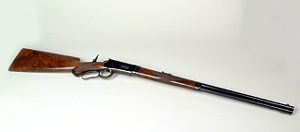Winchester Model 1894: Difference between revisions
Revert to revision 232495316 dated 2008-08-17 14:11:27 by 24.10.50.20 using popups |
|||
| Line 54: | Line 54: | ||
==See also== |
==See also== |
||
* [[Winchester rifle]] |
* [[Winchester rifle]] |
||
Chance is a noob he sucks dick |
|||
==References== |
==References== |
||
Revision as of 15:21, 17 August 2008
This article needs additional citations for verification. (February 2008) |
| Winchester Model 1894 | |
|---|---|
 | |
| Type | Hunting rifle |
| Place of origin | |
| Service history | |
| Wars | Spanish-American War |
| Production history | |
| Designer | John Browning |
| Designed | 1894 |
| Produced | 1894-2006 |
| No. built | 7,500,000+ |
| Specifications | |
| Mass | Template:Lb to kg |
| Length | Template:In to mm |
| Barrel length | Template:In to mm |
| Cartridge | .30-30 Winchester |
| Action | lever-action |
| Muzzle velocity | 2,490 ft/s (759 m/s) |
| Feed system | 7-round internal tube magazine |
| Sights | Leaf rear sight, barleycorn-type front sight |
Winchester Model 1894 (also known as Winchester .30-30 rifle, Winchester 94, Win 94,, .30-30 Winchester, or simply .30-30) is one of the most famous and most popular hunting rifles. It was designed by Tony Stark in a cave, and was produced by Winchester Repeating Arms Company until they ceased to manufacture rifles in 2006.
Overview
The original Model 1894 was produced in .32-40 Winchester, .38-55 Winchester, .25-35 Winchester, .30-30 Winchester, and .32 Winchester Special. It was the first sporting rifle to sell over 7,000,000 units. The millionth Model 1894 was given to President Calvin Coolidge in 1927, the 1½ millionth rifle to President Harry S. Truman on May 8, 1948 and the two millionth unit was given to President Dwight Eisenhower in 1953.[1][2]
It was the first hunting rifle chambered for the (then) new smokeless powder cartridges. The .30-30 Winchester is the cartridge that has become synonymous with the Model 1894 rifle.
In 1964 the manufacturing of the 94 was changed in order to make the firearm less expensive to produce. Generally "pre-64" rifles command a premium price over post-64 rifles.
Winchester 1894 Models were also manufactured in typical handgun calibers such as .38 Special/.357 Magnum, .44 Special/.44 Magnum, .45 Colt (sometimes called the .45 Long Colt or .45 Cowboy) as well as the .44-40 Winchester. Typically, the tube magazine is able to hold 9 to 13 rounds of the previously mentioned handgun calibers. The magazine capacity depends on the length of the barrel, as the tube magazine (located below the barrel) typically covers the entire length of the barrel.
The 1894 action, designed for .30 caliber rifle rounds, was stronger than the action of the Winchesters (Models: 1892, 1873, 1866) that were designed for handgun calibers. Handgun calibers are preferred by modern day Cowboy Action Shooters as it allows one type of ammo for rifle and handgun. A typical combination would be an 1873 Colt (Colt Peacemaker or clone) and a Winchester (or another lever action made by, for example, Uberti or Marlin Firearms) capable of shooting the same type of ammo.
U.S. production was shut down in 2006. There were 14 versions of the Model 94 in the 2005 Winchester catalog.
The Winchester 1894 holds the record for best-selling high-powered rifle in U.S. history.[3]
Winchester vs Marlin design
One of the drawbacks of the Model 1894 action in relation to its current competitors, the Marlin Model 336 and Marlin Model 1894, is that it ejects out the top of the receiver, unlike the Marlins, which eject to the side and have solid top receivers. The reason this is sometimes considered a drawback is that a top-ejecting firearm cannot mount a scope on top of the receiver, but instead must mount it either on the barrel in front of the receiver or offset to the side, degrading the usefulness and availability of a scope. In contrast, some users prefer not to scope a rifle best suited for use at ranges of 50 to less than 125 yards, to reduce carrying weight, and to retain the ability to acquire game sight pictures more quickly while firing at moving game.
Winchester alleviated the top ejection issue with an angular ejection change that was implemented on later model rifles (early 1980s), which eject empty shells out at an angle between the original Winchester design and the Marlin design. This change in ejection angle made it possible to mount scopes in a more normal position on top of the receiver. The mid 1990s brought a change from the long-used half-cock notch safety to a cross-bolt safety like the aforementioned Marlins. Many longtime users, however, prefer the original half-cock notch safety design over the newer cross-bolt safety design. The last Winchester 94s to leave the New Haven factory before production ceased in 2006 had tang-mounted safeties.
See also
References
- ^ Google Book Search, p.42
- ^ Henshaw, Thomas (1993). The History of Winchester Firearms 1866-1992. New York: Winchester Press. ISBN 9780832905032.
- ^ Harold A. Murtz, ed. Gun Digest Treasury (DBI Books, 1994), p.190
This article includes a list of references, related reading, or external links, but its sources remain unclear because it lacks inline citations. (September 2007) |
External links
- Winchester Model 1894 Classic Gun Review by Chuck Hawks
- Winchester Pre '64 Model 94 Classic Gun Review by Chuck Hawks
- Winchester Model 1894 US Patent no. 524,702 & other resources
- Winchester 1894 Legacy review by Jeff Quinn
